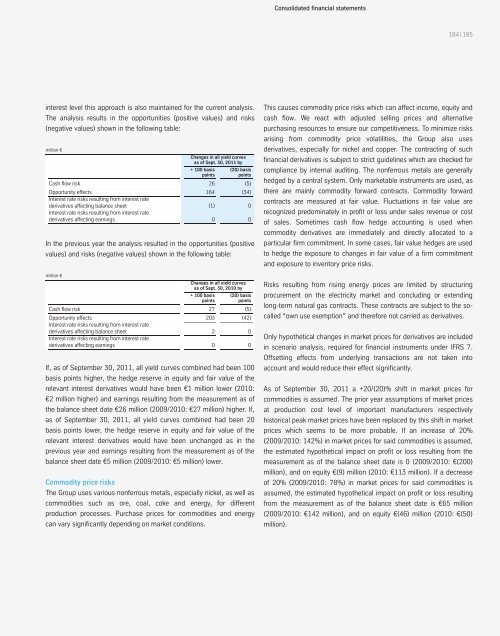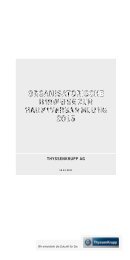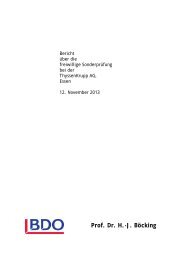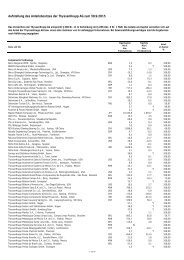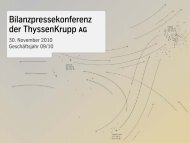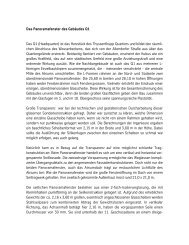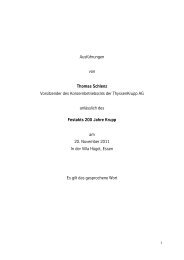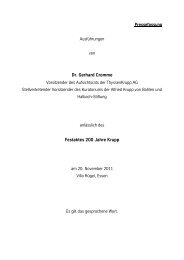PDF (10.9MB) - ThyssenKrupp AG
PDF (10.9MB) - ThyssenKrupp AG
PDF (10.9MB) - ThyssenKrupp AG
You also want an ePaper? Increase the reach of your titles
YUMPU automatically turns print PDFs into web optimized ePapers that Google loves.
3.6 Consolidated financial statements Notes to the consolidated financial statements<br />
interest level this approach is also maintained for the current analysis.<br />
The analysis results in the opportunities (positive values) and risks<br />
(negative values) shown in the following table:<br />
million €<br />
Changes in all yield curves<br />
as of Sept. 30, 2011 by<br />
+ 100 basis<br />
points<br />
(20) basis<br />
points<br />
Cash flow risk 26 (5)<br />
Opportunity effects<br />
Interest rate risks resulting from interest rate<br />
164 (34)<br />
derivatives affecting balance sheet<br />
Interest rate risks resulting from interest rate<br />
(1) 0<br />
derivatives affecting earnings 0 0<br />
In the previous year the analysis resulted in the opportunities (positive<br />
values) and risks (negative values) shown in the following table:<br />
million €<br />
Changes in all yield curves<br />
as of Sept. 30, 2010 by<br />
+ 100 basis<br />
points<br />
(20) basis<br />
points<br />
Cash flow risk 27 (5)<br />
Opportunity effects<br />
Interest rate risks resulting from interest rate<br />
203 (42)<br />
derivatives affecting balance sheet<br />
Interest rate risks resulting from interest rate<br />
2 0<br />
derivatives affecting earnings 0 0<br />
If, as of September 30, 2011, all yield curves combined had been 100<br />
basis points higher, the hedge reserve in equity and fair value of the<br />
relevant interest derivatives would have been €1 million lower (2010:<br />
€2 million higher) and earnings resulting from the measurement as of<br />
the balance sheet date €26 million (2009/2010: €27 million) higher. If,<br />
as of September 30, 2011, all yield curves combined had been 20<br />
basis points lower, the hedge reserve in equity and fair value of the<br />
relevant interest derivatives would have been unchanged as in the<br />
previous year and earnings resulting from the measurement as of the<br />
balance sheet date €5 million (2009/2010: €5 million) lower.<br />
Commodity price risks<br />
The Group uses various nonferrous metals, especially nickel, as well as<br />
commodities such as ore, coal, coke and energy, for different<br />
production processes. Purchase prices for commodities and energy<br />
can vary significantly depending on market conditions.<br />
Consolidated financial statements<br />
184 | 185<br />
This causes commodity price risks which can affect income, equity and<br />
cash flow. We react with adjusted selling prices and alternative<br />
purchasing resources to ensure our competitiveness. To minimize risks<br />
arising from commodity price volatilities, the Group also uses<br />
derivatives, especially for nickel and copper. The contracting of such<br />
financial derivatives is subject to strict guidelines which are checked for<br />
compliance by internal auditing. The nonferrous metals are generally<br />
hedged by a central system. Only marketable instruments are used, as<br />
there are mainly commodity forward contracts. Commodity forward<br />
contracts are measured at fair value. Fluctuations in fair value are<br />
recognized predominately in profit or loss under sales revenue or cost<br />
of sales. Sometimes cash flow hedge accounting is used when<br />
commodity derivatives are immediately and directly allocated to a<br />
particular firm commitment. In some cases, fair value hedges are used<br />
to hedge the exposure to changes in fair value of a firm commitment<br />
and exposure to inventory price risks.<br />
Risks resulting from rising energy prices are limited by structuring<br />
procurement on the electricity market and concluding or extending<br />
long-term natural gas contracts. These contracts are subject to the socalled<br />
“own use exemption” and therefore not carried as derivatives.<br />
Only hypothetical changes in market prices for derivatives are included<br />
in scenario analysis, required for financial instruments under IFRS 7.<br />
Offsetting effects from underlying transactions are not taken into<br />
account and would reduce their effect significantly.<br />
As of September 30, 2011 a +20/(20)% shift in market prices for<br />
commodities is assumed. The prior year assumptions of market prices<br />
at production cost level of important manufacturers respectively<br />
historical peak market prices have been replaced by this shift in market<br />
prices which seems to be more probable. If an increase of 20%<br />
(2009/2010: 142%) in market prices for said commodities is assumed,<br />
the estimated hypothetical impact on profit or loss resulting from the<br />
measurement as of the balance sheet date is 0 (2009/2010: €(200)<br />
million), and on equity €(9) million (2010: €113 million). If a decrease<br />
of 20% (2009/2010: 78%) in market prices for said commodities is<br />
assumed, the estimated hypothetical impact on profit or loss resulting<br />
from the measurement as of the balance sheet date is €65 million<br />
(2009/2010: €142 million), and on equity €(46) million (2010: €(50)<br />
million).


